
Telephony integration with Salesforce helps your sales and support teams handle phone calls directly from Salesforce, see customer details during calls, and automatically log call information.
In today’s digital age, connecting phone systems with Salesforce is essential. Approximately 50% of consumers prefer using voice channels for customer service interactions. With 65% of customers wanting quick support, telephony integration can help improve satisfaction. An impressive 70% of consumers believe that voice will remain a vital channel for customer service moving forward. These numbers show how important telephony integration is for better customer service and efficiency.
In this guide you will find how to set up telephony integration, some useful apps to make it happen, cost considerations, and insights to ensure a smooth implementation.
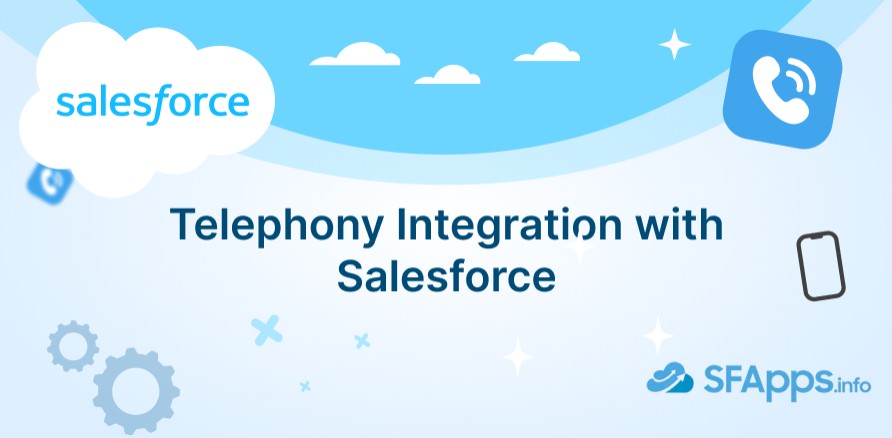
What Is Telephony Integration with Salesforce?
Salesforce telephony integration (also called Computer Telephony Integration, or CTI) allows you to connect your phone system to Salesforce. This means when a customer calls, your team can answer, view customer details, and log everything in Salesforce without needing to switch between different tools.
With telephony integration, users can make and receive calls directly from Salesforce, view customer information during calls, automatically log calls, and create records related to the conversations. For service and support teams, Salesforce Service Cloud telephony integration enhances productivity by providing instant access to customer profiles, past interactions, and case histories, ensuring quicker resolution times.
Benefits of Telephony Integration in Salesforce
- Centralized communication: by integrating telephony with Salesforce, all phone interactions are stored in a single place, making it easier for sales and service teams to track, analyze, and act on customer data.
- Improved productivity: teams no longer need to switch between multiple tools to manage calls and CRM data, reducing the time spent on manual tasks such as call logging.
- Enhanced customer experience: agents can access a caller’s information instantly, allowing them to provide more personalized and efficient support.
- Data-driven insights: by tracking all interactions within Salesforce, businesses can generate detailed reports on call volume, call outcomes, and agent performance.
Insight:
Improved Customer Experience
Integrating telephony with Salesforce gives agents access to complete customer data, enhancing service efficiency and reducing frustration. With 82% of organizations using unified CRM systems, these integrations are essential for building customer trust and satisfaction in a competitive landscape.
Step-by-Step Guide to Setting up Telephony Integration in Salesforce
Step 1: Choose the right phone system
Before setting up your call center in Salesforce, it’s essential to choose the right phone system for your business. Here are the main options:
1. VoIP Services (Voice over IP)
VoIP systems use the internet for calls, offering flexibility and cost savings. Popular options include:
- RingCentral: a full communication platform with voice, video, and messaging, seamlessly integrating with Salesforce.
- Twilio: customizable for advanced features, ideal for businesses needing a tailored setup.
- Aircall: easy-to-use for sales and support teams, with call logging and click-to-dial within Salesforce.
2. Traditional PBX Systems
If you already have a physical phone setup (PBX), you may want to stick with it. While computer telephony integration Salesforce is possible, it might require additional setup, such as a CTI adapter.
3. Cloud-Based Phone Systems
These systems, like Five9 and Talkdesk, are designed for high call volumes in contact centers and integrate smoothly with Salesforce, providing advanced features like call tracking and analytics.
Factors to Consider When Choosing
- Business Needs: how many users? Remote work or office-based? Sales or customer service focus?
- Salesforce Integration: if you prefer a different tool, make sure the system supports Salesforce Open CTI to allow for seamless integration.
- Budget: choose a system that fits your budget and offers the key features you need.
Step 2: Install and Integrate Your Telephony App
Before setting up the call center, you need to integrate your chosen telephony system with Salesforce. Most telephony providers offer apps or CTI adapters that can be installed from Salesforce AppExchange. Follow these steps:
- Install the App:
- Go to AppExchange and search for the app provided by your telephony service (e.g., RingCentral, Twilio, or Five9).
- Install the app into your Salesforce org, ensuring you have the necessary permissions.
- Connect and Configure the App: after installation, follow the provider’s guide to complete the integration. This typically involves:
- Logging into your telephony system via the Salesforce app.
- Authorizing the connection between Salesforce and your telephony system.
- Setting up call routing, user permissions, and other features.
You can also use CallRail for telephony integration. Check out Callrail Salesforce Integration to learn how to set it up.
Step 3: Set up the Call Center in Salesforce
Now that your telephony system is integrated, you can proceed to set up the Call Center in Salesforce:
- Obtain the Call Center Definition File from your telephony provider. This file (XML) includes all the configuration details for connecting Salesforce to your phone system.
- Import the Call Center Definition File:
- In Salesforce Setup, search for Call Centers:
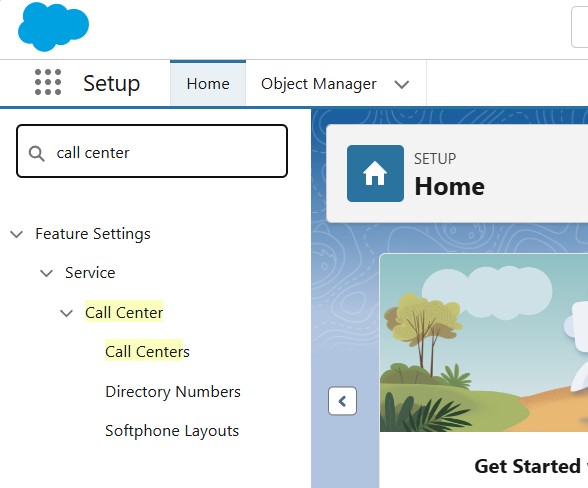
- Check the information about the Call Center and click continue:
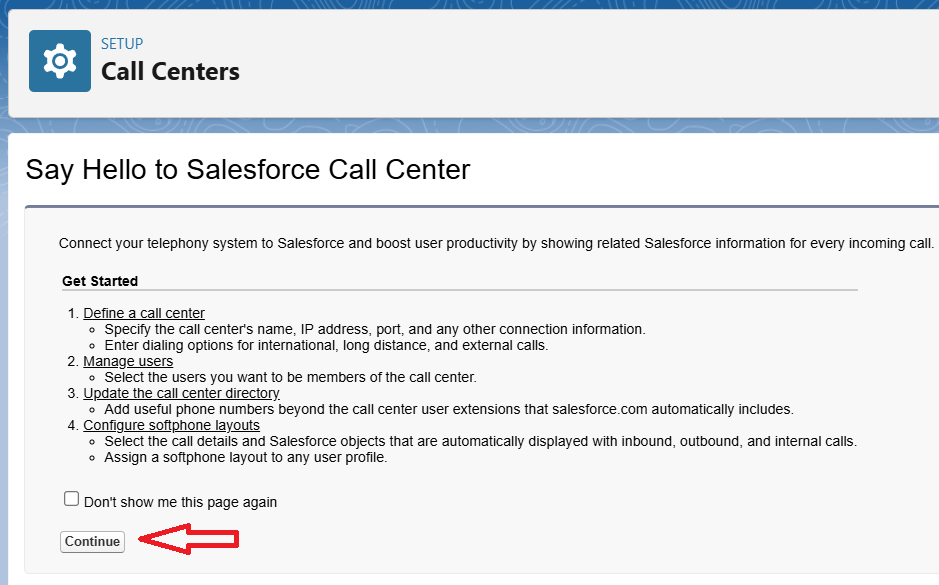
- Upload the Call Center Definition File by clicking “Choose File”, then select the file.
- Click Import to complete the setup:
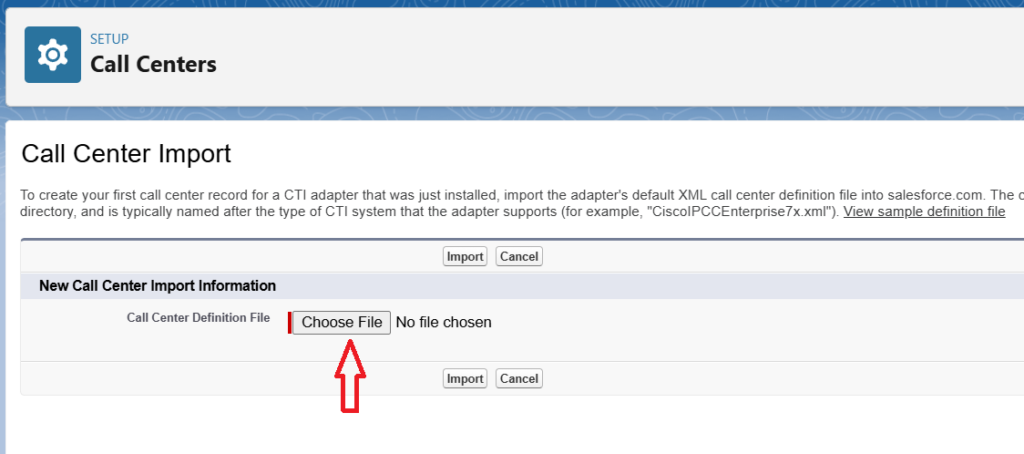
With the call center configured, your team can start managing calls directly from Salesforce. The telephony integration Salesforce allows for features like click-to-dial, call logging, and automatic screen pops for incoming calls.
Step 4: Test the Integration
Test the system by making a few phone calls. Check if:
- Call logs are automatically created in Salesforce.
- Calls can be made directly from Salesforce.
- Customer details appear during incoming calls.
You can also set up custom fields and workflows to match your business needs.
Recommended Apps for Telephony Integration with Salesforce
Integrating telephony systems with Salesforce enhances your team’s productivity, improves customer experience, and streamlines communication. Here are some of the most popular apps that facilitate Salesforce call center integration:
1. RingCentral for Salesforce
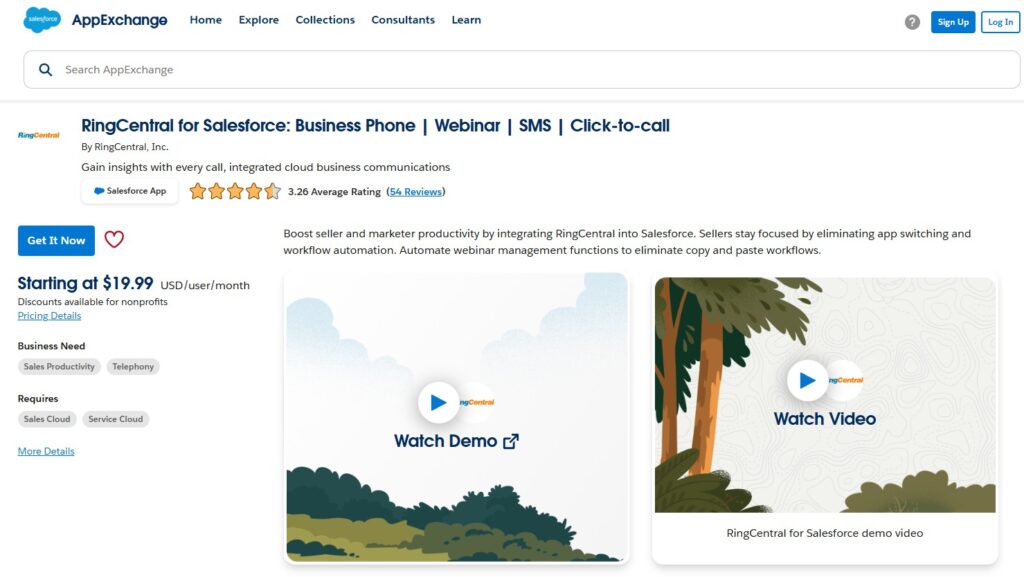
Overview:
RingCentral is a comprehensive cloud-based communication platform that consolidates voice, video, messaging, and collaboration tools into a single solution. Its integration with Salesforce allows businesses to manage their communication efficiently while enhancing customer interactions.
Key Features:
- Click-to-Dial Functionality: users can initiate calls directly from Salesforce records with a simple click, which minimizes dialing errors and saves time.
- Automatic Call Logging: the app automatically logs call details into Salesforce, including call duration, time, and participants, ensuring that all customer interactions are tracked without manual input.
- Real-Time Customer Insights: during calls, agents have immediate access to customer profiles and historical interactions, which enables personalized conversations that enhance customer satisfaction.
- Advanced Reporting and Analytics: provides insights into call performance metrics such as call volumes, duration, and outcomes, helping managers identify areas for improvement.
Benefits:
By using RingCentral, businesses can improve collaboration among team members, boost efficiency in communication, and ensure that all customer interactions are accurately documented in Salesforce, which is crucial for maintaining a complete customer history.
2. Aircall
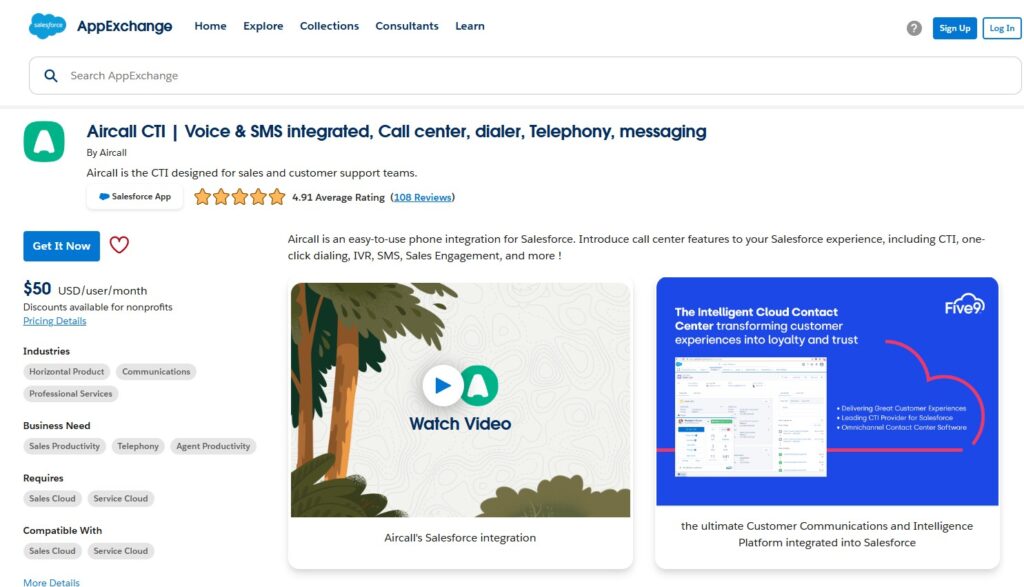
Overview:
Aircall is a cloud-based phone system designed specifically for sales and support teams. It provides an intuitive interface and powerful features that facilitate call management and integration with Salesforce.
Key Features:
- Real-Time Call Monitoring and Coaching: managers can listen to live calls, enabling them to provide real-time feedback and coaching to agents, improving their performance and customer service skills.
- Efficient Call Queues: the app intelligently routes incoming calls to available agents, which reduces customer wait times and enhances service levels.
- Multiple Integrations: in addition to Salesforce, Aircall integrates with tools like Slack, HubSpot, and Zendesk, allowing teams to maintain a unified view of customer interactions across platforms.
- Voicemail Management and Call Routing: offers advanced features for managing voicemail and customizing call routing based on various criteria, ensuring timely responses to customer inquiries.
Benefits:
Aircall is particularly beneficial for small to medium-sized businesses aiming to streamline their communication processes. Its seamless integration with Salesforce allows for efficient tracking and management of calls, leading to improved customer service outcomes.
3. Twilio Flex
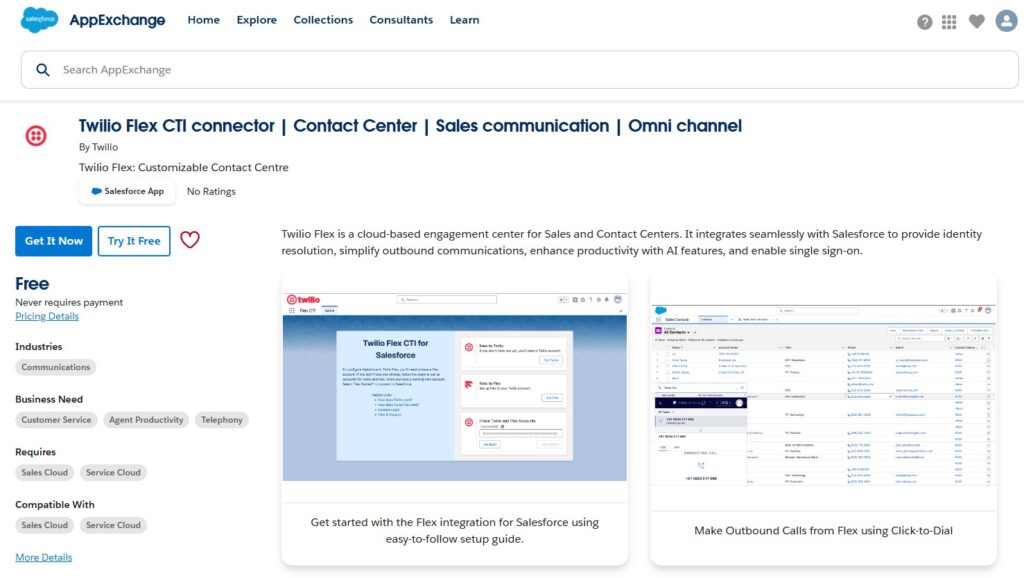
Overview:
Twilio Flex is a fully customizable contact center platform that allows businesses to adapt their customer service operations according to their specific needs. It leverages Open CTI for integration with Salesforce, offering a robust solution for managing customer interactions.
Key Features:
- Customizable Agent Interface: businesses can tailor the agent interface to align with their workflows, selecting the tools and information most relevant to their operations.
- Multi-Channel Support: Flex allows teams to handle calls, SMS, and chat messages from a single interface, creating a seamless experience for agents and customers.
- Programmable Workflows: organizations can automate routine tasks and workflows, such as call distribution and follow-up actions, freeing up agents to focus on customer interactions.
- In-Depth Analytics and Reporting: provides comprehensive analytics tools to track key performance indicators (KPIs), helping managers optimize their operations based on data-driven insights.
Benefits:
Twilio Flex is an ideal choice for businesses needing a tailored customer service solution. Its integration with Salesforce enhances the customer experience while offering the flexibility to customize workflows and communication channels.
4. Five9
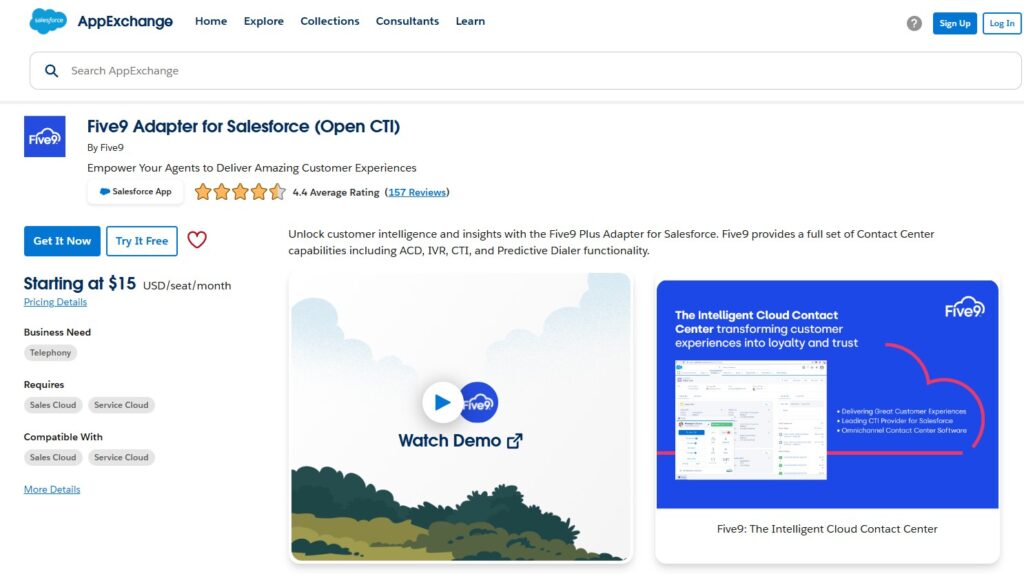
Overview:
Five9 is a leading cloud contact center solution designed to optimize customer interactions and improve operational efficiency. It is particularly well-suited for larger teams and enterprises looking to scale their customer service capabilities.
Key Features:
- Predictive Dialing Technology: automatically dials customer numbers, ensuring agents spend more time talking to customers rather than waiting for calls to connect, which maximizes productivity.
- Deep CRM Integration: Five9 integrates seamlessly with Salesforce, enabling agents to access customer information and interaction history directly from the platform.
- Omni-Channel Communication: supports a variety of communication channels, including voice, email, chat, and social media, allowing agents to interact with customers on their preferred platforms.
- Real-Time Analytics: offers detailed insights into agent performance, call outcomes, and customer satisfaction, empowering managers to make informed decisions and improve service quality.
Benefits:
With its robust features and seamless Salesforce integration, Five9 enables businesses to enhance their customer support efforts, drive sales, and improve overall customer satisfaction through efficient communication.
5. Talkdesk for Salesforce
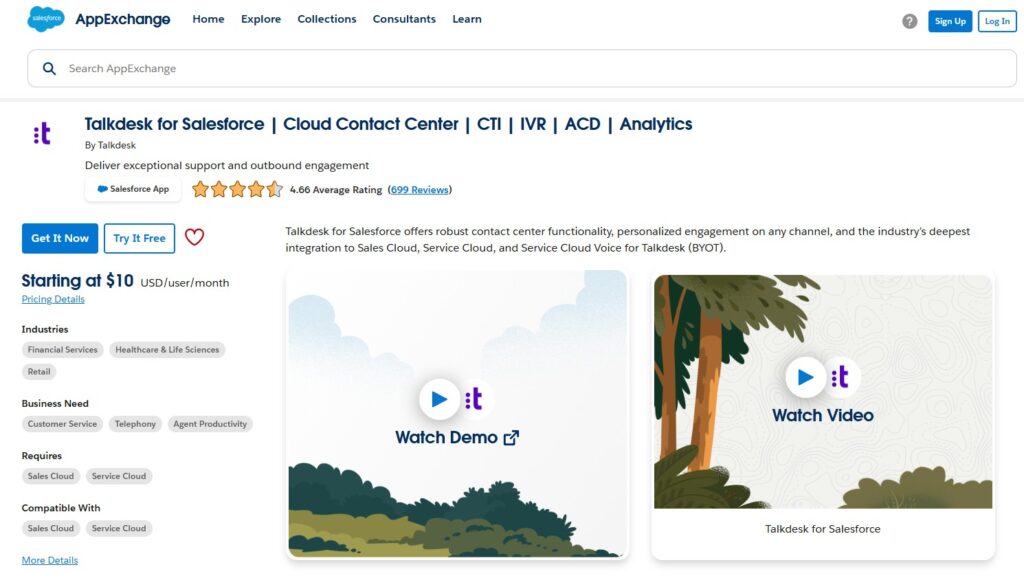
Overview:
Talkdesk is a cloud-based customer service software that provides an easy-to-use interface and strong integration capabilities with Salesforce. It is designed to streamline customer interactions and improve agent productivity.
Key Features:
- Automatic Call Distribution (ACD): smartly routes incoming calls to the most suitable agents based on various criteria, enhancing first-call resolution rates and customer satisfaction.
- Speech Analytics: utilizes AI to analyze customer conversations, providing valuable insights into customer sentiment and agent performance, which can inform training and quality assurance processes.
- Integration with Salesforce: agents can view customer profiles, interaction history, and relevant data during calls, facilitating a personalized and efficient service experience.
- Workforce Management Tools: provides solutions for managing agent schedules, monitoring performance, and ensuring that staffing levels meet customer demand, leading to better service delivery.
Benefits:
Talkdesk empowers businesses to improve their customer service operations significantly. Its seamless integration with Salesforce ensures that teams can respond quickly to customer needs while maintaining a comprehensive record of interactions.
Insight:
Salesforce CTI telephony integration automates tasks such as call logging, allowing teams to focus on customer engagement instead of administrative work. It also provides valuable analytics on call data, helping organizations identify trends and make informed decisions for future improvements.
Cost of Telephony Integration in Salesforce
The cost of telephony integration in Salesforce depends on your setup and the size of your business. Here are a few things that affect the price:
1. Salesforce Native Solutions
If you use Salesforce’s built-in voice services, like Service Cloud Voice, the cost will depend on your Salesforce subscription. Prices typically start at about $50 per user per month.
2. Third-Party Telephony Providers
Third-party apps like RingCentral or Aircall have their own pricing plans, which usually depend on the number of users. For example:
- RingCentral: Core starts at $30 per user per month Advanced $35 and Ultra $45. You can save up to 33% by paying annually.
- Aircall: Essentials starts at $30 per user per month, Professional $70 has Salesforce integration and also you can get a customised Aircall package aligned with your business needs.
- Twilio Flex: uses a pay-as-you-go model, charging per minute and user, so the cost will vary based on usage.
3. Custom Integrations
If you need a custom Salesforce telephony integration API or have a unique setup (like an on-premise phone system), development costs can vary widely. Custom solutions might range from a few thousand dollars for small businesses to over $100,000 for large companies with complex needs.
Tips for a Successful Telephony Integration
- Automate as much as possible: use Salesforce to automatically log calls, create follow-up tasks, and update customer records. This will save your team a lot of time.
- Monitor call data: use Salesforce’s reporting tools to track call volume, average call time, and customer satisfaction. These insights can help you make improvements.
For more insights on setting up your call center, see the Salesforce Call Center Integration.
Final Thoughts
Telephony integration with Salesforce can make a huge difference in how your team handles customer calls and manages data. It brings all phone interactions into one place, improves customer service, and helps your team work faster and smarter.
Whether you choose a third-party app or build a custom solution, telephony integration is worth the investment. Consider the costs, follow the setup steps carefully, and monitor your results to get the most out of your integration.
For more information on Salesforce integrations, explore the comprehensive Salesforce IVR to learn more about connecting various applications and systems.

Dorian is a 6X Certified Salesforce Developer and Administrator with a start in the IT world as a CRM Admin in 2020. Since diving into Salesforce in 2021 via Trailhead and Focus on Force, he has achieved a Ranger Rank, earned several Superbadges, and bagged certifications including the Salesforce Certified Administrator, Platform App Builder, Associate and Platform Developer I by 2023. In 2024 he also became Salesforce Certified AI Associate and earned Certified AI Specialist Certification in 2025. Dorian is very keen on continuous learning, always looks for fresh ways to improve his knowledge. He enjoys running, boxing, kickboxing and reading diverse kinds of books in his free time.


 Previous Post
Previous Post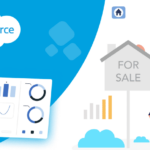 Next Post
Next Post